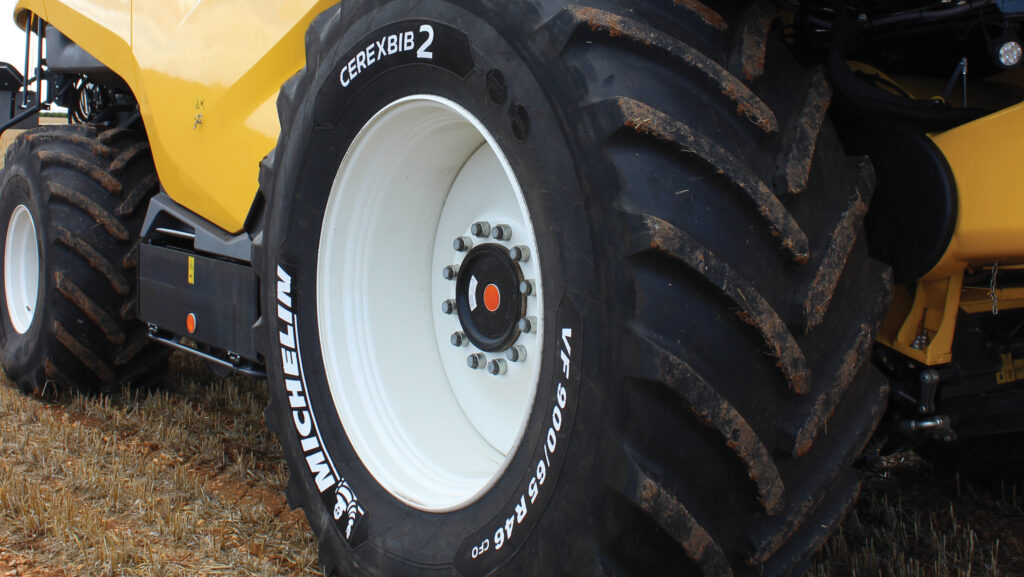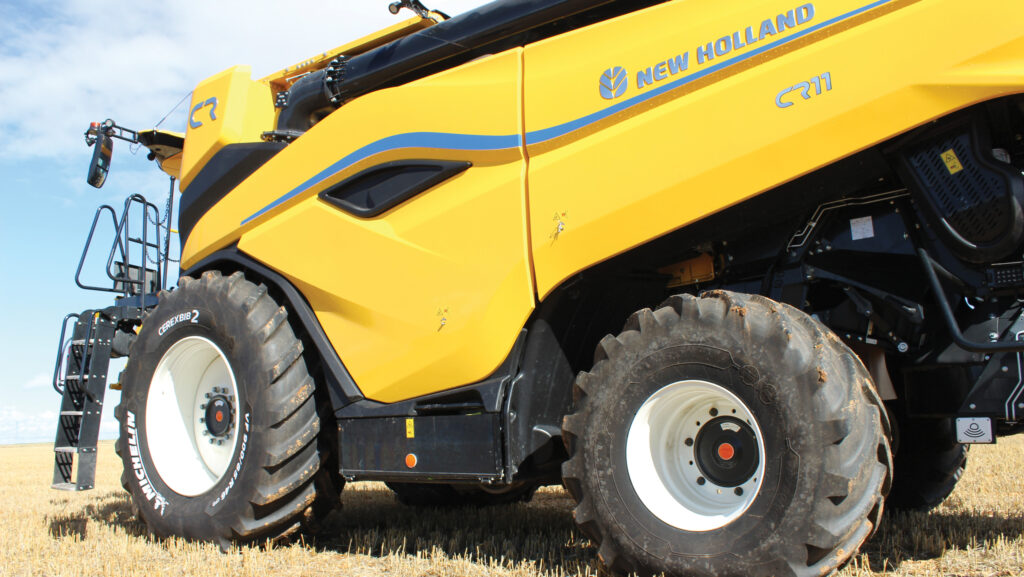Michelin develops huge Cerexbib 2 harvester tyres with CNH
 © Peter Hill
© Peter Hill Twenty years after Michelin introduced the Xeobib, heralding something of a revolution in traction tyre performance, the French manufacturer has produced its most heavyweight low ground pressure VF design yet.
The Cerexbib 2 in the new size VF 900/65 R46 CFO is matched in its dimensions by the largest Axiobib 2 traction tyre designed for high-horsepower tractors.
But the Cerexbib 2 CFO is designed specifically for heavy harvesters, with a greater emphasis on outright load-carrying capacity, which in this case is up to 19t.
See also: High-flexion tractor tyres – how they work and what they cost
Designed alongside the equally new VF 800/70 R46 CFO, the big tyres were commissioned specifically for the New Holland CR11 combine, launched in the field this year, to meet a significant challenge.
While for practical reasons most UK operators would want the combine on tracks – it spans almost 4m on the 900s – there will be demand in some markets for the lower cost, long-life and maintenance-free tyre option.
But the harvester R&D team in Zedelgem, Belgium wanted tyres that could not only cope with the combine’s weight – it has a bigger grain tank and larger rotors, and can work with wider draper headers – but also reduce its impact on the soil compared with the CR10.90 Evolution.

© Peter Hill
It was a tall order, and Michelin’s engineers came up with a tall solution – the first 2.32m diameter harvester drive tyre, providing a large load-carrying volume and durable but highly flexible sidewall technology that enables it to run at relatively low inflation pressure.
This solution set CNH’s “future combine” design engineers a counter-challenge: finding space for the 900mm tyre, which required the frame, bodywork and other components to be worked around its big dimensions.
It also resulted in a new drop axle at the front to keep the combine’s overall height below the 4m legal limit for the road, and the novel use of the two threshing/separation rotor shafts to send drive forwards to the header to save crucial millimetres of space.
Lower ground pressure
The work paid off; despite its considerable heft, the CR11 has an average ground pressure across the front and rear axles 7% less than the CR10.90 Evolution’s.
Michelin’s Ultraflex sidewall design principles are at the core of the new tyre’s structure, a technology that made its 2004 debut with the Xeobib and is now used for numerous Michelin traction and flotation tyres.
It introduced the now familiar VF performance characteristics, including the ability to carry a given load at 40% lower inflation pressure than a “standard” tyre of equivalent size.
But while several manufacturers now have products that meet this high-tech category definition, Anne-Laure Fraenkel, Michelin’s ag tyre R&D project co-ordinator, insists that not all VF tyres are equal.
She argues that the patented Ultraflex sidewall design that enables the tyres (subject to load, speed and application) to operate at less than 1bar (14.5psi), while spreading the load effectively over the entire contact patch, keeps Michelin’s VF products ahead of the field.
What does CFO mean?
All tyres intended for use with heavy combines, beet and potato harvesters carry the CFO marking at the end of the size description.
It stands for Cyclic Field Operation and recognises that the tyre will be used at low speeds carrying transient loads; when combining, for example, the maximum load the tyres must carry is reached only for a short period when the tank is full.
That allows some leeway in the usual load/speed/pressure relationship to get maximum benefit in terms of outright carrying capacity and the lowest possible inflation pressure.
VF tyre benefits
Is it worth investing in higher-priced VF-specification tyres?
Independent trials conducted by agricultural universities around the world – including Harper Adams in Shropshire – using Michelin VF tractor tyres suggest it is, given the yield gains and long-term soil health benefits seen as a result of reduced compaction.
Overall, the trials staged in the UK, the United States, Brazil and China saw yield improvements of 2-4%, increased soil permeability – so rain water was able to infiltrate the ground more quickly – and 10-11% lower fuel consumption, alongside productivity gains of about 2.5% from improved traction.

